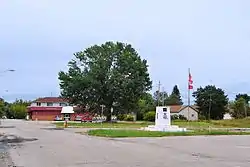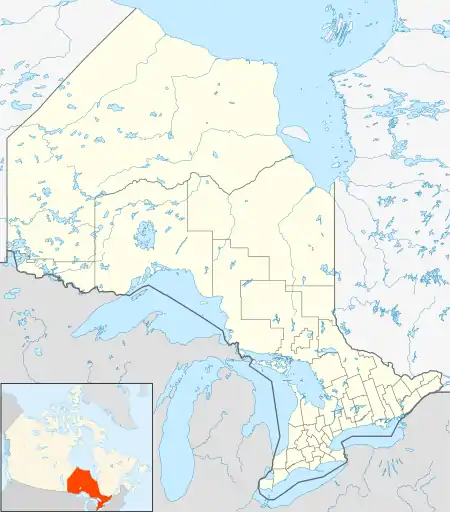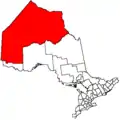Ignace
Ignace /ˈɪɡneɪs/ is a township in the Kenora District of Northwestern Ontario, Canada, located at Highway 17 (Trans Canada Highway) and Secondary Highway 599, and on the Canadian Pacific Railway between Thunder Bay and Kenora. It is on the shore of Agimak Lake, and as of 2016, the population of Ignace was 1,202.
Ignace | |
|---|---|
| Township of Ignace | |
 | |
 Ignace | |
| Coordinates: 49°25′N 91°40′W | |
| Country | Canada |
| Province | Ontario |
| District | Kenora |
| Founded | 1879 |
| Incorporated | 1908 |
| Government | |
| • Mayor | Cory Olivier |
| • Federal riding | Kenora |
| • Prov. riding | Kenora—Rainy River |
| Area | |
| • Land | 72.82 km2 (28.12 sq mi) |
| Population (2016)[1] | |
| • Total | 1,202 |
| • Density | 16.5/km2 (43/sq mi) |
| Time zone | UTC-6 (CST) |
| • Summer (DST) | UTC-5 (CDT) |
| Postal code | P0T 1T0 |
| Area code(s) | 807 |
| Website | town.ignace.on.ca |
The town was named after Ignace Mentour by Sir Sandford Fleming in 1879. Ignace Mentour was the key aboriginal guide through this region during Fleming's 1872 railway survey, recorded in George Monro Grant's journal of the survey, Ocean to Ocean. Mentour had also served with Sir George Simpson in Simpson's final years as governor of Rupert's Land.
During Ignace's early days, there was a settlement of railway boxcars used by the English residents there called "Little England."
Although Ignace was incorporated in 1908, it was something of a latecomer to some modern conveniences, such as rotary dial telephone, which did not arrive to the town until 1956.
Forestry and tourism support Ignace's economy, today, and one attraction is the 3-storey log White Otter Castle, located on White Otter Lake at Turtle River, and built by James Alexander McOuat between 1903 and 1914.
Ignace is one of 6 Ontario communities[2] being considered as a potential deep geological repository site for Canada’s used nuclear fuel. Initial Borehole drilling and core sample testing is taking place in a rock formation known as the Revell Batholith, located south of Highway 17, about 35 kilometres west of Ignace (between Ignace and Wabigoon Lake Ojibway Nation).
In the 1950s, Ignace saw its first newspaper, the Village Tattler, started there to serve the town, published by the local YMCA. In 1971, Dennis Smyk started the Ignace Driftwood, which was suspended two years later, but was revived in 1979 and ran until 2018. During Driftwood's suspension, the Ignace Courier was published for the town's local news.
Demographics
| Canada census – Ignace community profile | |||
|---|---|---|---|
| 2016 | 2011 | 2006 | |
| Population: | 1,202 (0% from 2011) | 1,202 (-16.0% from 2006) | 1,431 (−16.3% from 2001) |
| Land area: | 72.82 km2 (28.12 sq mi) | 72.66 km2 (28.05 sq mi) | 72.66 km2 (28.05 sq mi) |
| Population density: | 16.5/km2 (43/sq mi) | 16.5/km2 (43/sq mi) | 19.7/km2 (51/sq mi) |
| Median age: | 52.5 (M: 52.4, F: 52.8) | 48.1 (M: 48.6, F: 47.7) | 42.5 (M: 42.7, F: 42.2) |
| Total private dwellings: | 711 | 680 | 741 |
| Median household income: | $60,928 | $57,250 | |
| References: 2016[3] 2011[4] 2006[5] earlier[6] | |||
Historic populations:[1][6][7]
- Population in 2016: 1,202 (unchanged from 2011)
- Population in 2011: 1,202 (-16.0% from 2006)
- Population in 2006: 1,431 (-16.3% from 2001)
- Population in 2001: 1,709 (-4.1% from 1996)
- Population in 1996: 1,782 (-7.9% from 1991)
- Population in 1991: 1,935
Local media
Newspapers
- Ignace Driftwood – In 1971, Dennis Smyk started the Ignace Driftwood, which was suspended two years later, but was revived in 1979 and ceased operations in 2018. During Driftwood's suspension, the Mattabi Memo and the Ignace Courier were published for the town's local news.
Radio
- CBES AM 690 (CBC Radio One) – rebroadcast transmitter of station based in Thunder Bay
- CKDR AM 1340 – rebroadcast transmitter of station based in Dryden
References
- "Ignace census profile". 2016 Census of Population. Statistics Canada. Retrieved 2018-04-13.
- "Study Areas | The Nuclear Waste Management Organization (NWMO)". www.nwmo.ca. Retrieved 2017-11-11.
- "2016 Community Profiles". 2016 Canadian Census. Statistics Canada. February 21, 2017. Retrieved 2019-06-06.
- "2011 Community Profiles". 2011 Canadian Census. Statistics Canada. July 5, 2013. Retrieved 2012-04-03.
- "2006 Community Profiles". 2006 Canadian Census. Statistics Canada. March 30, 2011. Retrieved 2011-06-27.
- "2001 Community Profiles". 2001 Canadian Census. Statistics Canada. February 17, 2012.
- Statistics Canada: Canada 1996 Census

